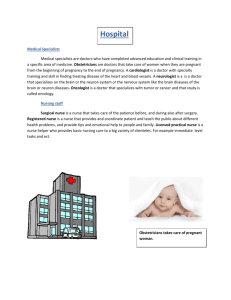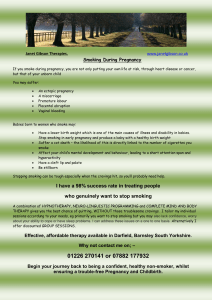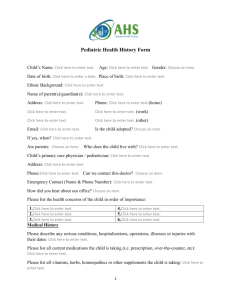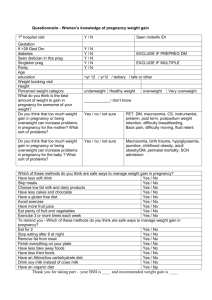Chapter 11
advertisement
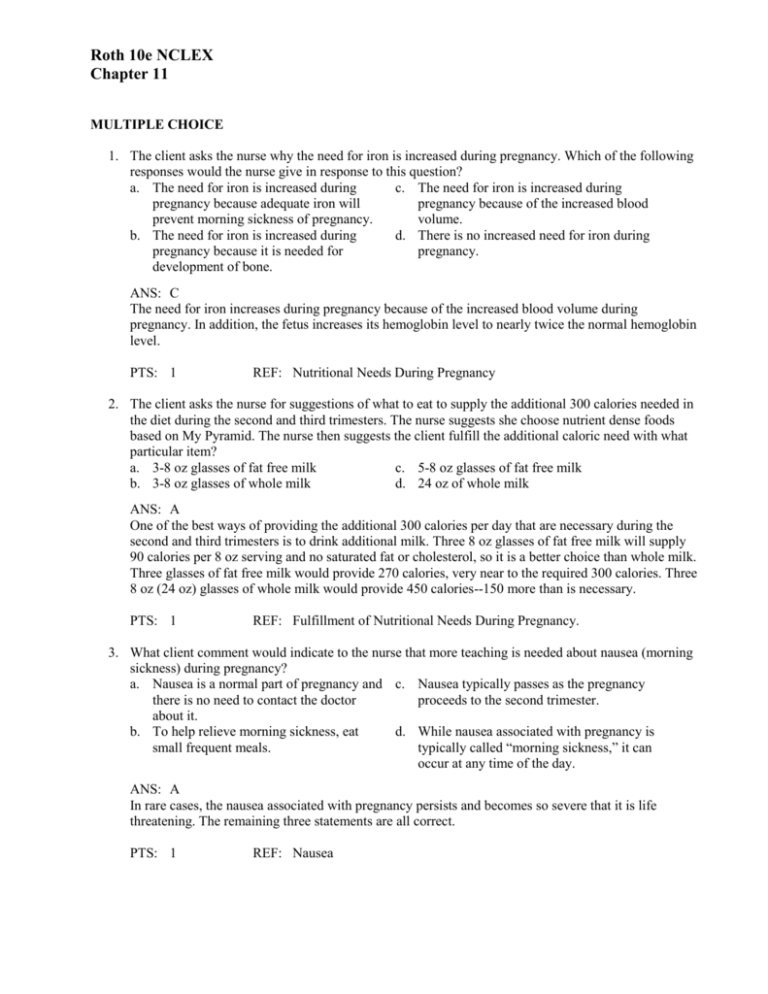
Roth 10e NCLEX Chapter 11 MULTIPLE CHOICE 1. The client asks the nurse why the need for iron is increased during pregnancy. Which of the following responses would the nurse give in response to this question? a. The need for iron is increased during c. The need for iron is increased during pregnancy because adequate iron will pregnancy because of the increased blood prevent morning sickness of pregnancy. volume. b. The need for iron is increased during d. There is no increased need for iron during pregnancy because it is needed for pregnancy. development of bone. ANS: C The need for iron increases during pregnancy because of the increased blood volume during pregnancy. In addition, the fetus increases its hemoglobin level to nearly twice the normal hemoglobin level. PTS: 1 REF: Nutritional Needs During Pregnancy 2. The client asks the nurse for suggestions of what to eat to supply the additional 300 calories needed in the diet during the second and third trimesters. The nurse suggests she choose nutrient dense foods based on My Pyramid. The nurse then suggests the client fulfill the additional caloric need with what particular item? a. 3-8 oz glasses of fat free milk c. 5-8 oz glasses of fat free milk b. 3-8 oz glasses of whole milk d. 24 oz of whole milk ANS: A One of the best ways of providing the additional 300 calories per day that are necessary during the second and third trimesters is to drink additional milk. Three 8 oz glasses of fat free milk will supply 90 calories per 8 oz serving and no saturated fat or cholesterol, so it is a better choice than whole milk. Three glasses of fat free milk would provide 270 calories, very near to the required 300 calories. Three 8 oz (24 oz) glasses of whole milk would provide 450 calories--150 more than is necessary. PTS: 1 REF: Fulfillment of Nutritional Needs During Pregnancy. 3. What client comment would indicate to the nurse that more teaching is needed about nausea (morning sickness) during pregnancy? a. Nausea is a normal part of pregnancy and c. Nausea typically passes as the pregnancy there is no need to contact the doctor proceeds to the second trimester. about it. b. To help relieve morning sickness, eat d. While nausea associated with pregnancy is small frequent meals. typically called “morning sickness,” it can occur at any time of the day. ANS: A In rare cases, the nausea associated with pregnancy persists and becomes so severe that it is life threatening. The remaining three statements are all correct. PTS: 1 REF: Nausea 4. The nurse is teaching a breastfeeding mother about the need for the mother to consume additional calories during lactation. How many additional calories above the mother’s usual caloric needs will the nurse say the breastfeeding mother should consume during lactation? a. 300 c. 640 b. 500 d. 750 ANS: B During the first 6 months of breastfeeding, the mother requires approximately 640 calories a day above her usual caloric needs. The Food and Nutrition Board suggests that breastfeeding mothers consume and additional 500 calories above the usual caloric need. This is less than the actual need because it is assumed that some fat has been stored during pregnancy, which can be used for milk production. PTS: 1 REF: Calorie Requirements during Lactation MULTIPLE RESPONSE 1. Which of the following client comments indicate to the nurse that the pregnant client understands the teaching on weight gain and caloric intake during pregnancy? Select all that apply. a. During the first trimester, average weight gain is a total of 2-4 pounds. d. On average, a pregnant adult requires an additional 100 calories a day above her usual requirement during the first trimester of pregnancy. b. During the second trimester of pregnancy, e. On average, a pregnant adult requires an average weight gain is 2 pounds per week. additional 300 calories a day above her usual requirement during the second and third trimesters of pregnancy. c. If one is overweight when they become f. Overweight women should not gain less pregnant, then weight loss should be a than 15 pounds during the pregnancy. goal during pregnancy. ANS: A, E, F During the first trimester of pregnancy, there is a weight gain of only 2-4 pounds. Most of the weight gain occurs during the second and third trimesters when it averages about 1 pound per week. Overweight women should not gain less than 15 pounds. No one should lose weight during pregnancy, because doing so could cause nutrient deficiencies for both the mother and the infant. On average, a pregnant adult requires no additional calories during the first trimester of pregnancy and only an additional 300 calories per day during the second and third trimesters. PTS: 1 REF: Weight Gain During Pregnancy 2. The nurse is counseling a pregnant client on the dangers of smoking during pregnancy. What client comments demonstrate to the nurse that more teaching is needed on the topic of smoking while pregnant? Select all that apply. a. Having a high birth weight baby may be a d. Smoking while pregnant puts the baby at consequence of smoking while pregnant. increase risk of Sudden Infant Death. b. Quitting smoking will allow the thyroid e. Spontaneous abortion may be a hormones to return to normal. consequence of smoking while pregnant. c. Smoking affects thyroid hormone function f. Thyroid hormones can be prescribed to in both the mother and child. help maintain the pregnancy, so it isn’t necessary to quit smoking. ANS: A, F Smoking while pregnant is very detrimental to the baby. Sudden Infant Death, low birth weight, premature births, cleft palate, and spontaneous abortions are known consequences of smoking while pregnant. Smoking also affects the thyroid hormone function in both mother and child. Thyroid hormones help maintain a pregnancy, but does not alleviate the other risks. Quitting smoking will allow the thyroid hormones to return to normal. PTS: 1 REF: In the Media 3. The nurse counsels a pregnant client who is taking supplemental vitamin A that the need for vitamin A is not increased during pregnancy. Which of the following effects could the nurse say are associated with excess vitamin A? Select all that apply. a. cleft lip b. heart defects c. hydrocephaly d. mental retardation e. Microcephaly f. spina bifida ANS: A, B, C, D, E Current research indicates there is no need for increased vitamin A during pregnancy. Excess vitamin A has been know to cause birth defects such as hydrocephaly, microcephaly, mental retardation, eye and ear abnormalities, cleft lip and palate, and heart defects. The nutrient deficiency associated with spina bifida is folic acid. PTS: 1 REF: Nutritional Needs During Pregnancy 4. A client asks the nurse for suggestions of ways to reduce or eliminate constipation. Which of the following suggestions would the nurse make? Select all that apply. a. Drink at least thirteen 8 oz glasses of liquid each day. b. Eat high fiber foods. c. Get some exercise every day. d. Get used to it. e. Limit water to four 8 oz glasses a day. f. Try to rest as much as possible. ANS: A, B, C Constipation can be relieved by eating high-fiber foods, getting daily exercise, drinking at least 13 glasses of liquid each day, and responding immediately to the urge to defecate. PTS: 1 REF: Constipation 5. The pregnant client tells the nurse that her mother almost died as a result of preeclampsia and wants to know more about it. Which of the following statements could the nurse make about preeclampsia? Select all that apply. a. Due to medical advances no one dies as a d. Pregnancy-induced hypertension occurs result of pregnancy-induced hypertension. more frequently in first time pregnancies. b. One characteristic of pregnancy-induced e. Pregnant adolescents have a higher rate of hypertension is edema that causes a pregnancy-induced hypertension than do sudden increase in weight. pregnant adults. c. Preeclampsia is now called pregnancyf. The cause of pregnancy-induced induced hypertension. hypertension is not known. ANS: B, C, D, E, F Pregnancy-induced hypertension was formerly called “toxemia” or “preeclampsia.” It is a condition that sometimes occurs in the third trimester. It is characterized by high blood pressure, the presence of albumin in the urine, and edema. The edema causes a sudden increase in weight. If the condition reaches the eclamptic stage, convulsions, coma, and death may occur. The cause of this condition is not known, but it occurs more frequently in first pregnancies, multifetal pregnancies, in women with morbid obesity, and among pregnant women on inadequate diets. Pregnant adolescents have a higher rate of pregnancy-induced hypertension than do pregnant adults. PTS: 1 REF: Pregnancy-Induced Hypertension 6. The nurse is teaching a group of pregnant clients about breastfeeding. What benefits could the nurse say there are for the breastfed infant? Select all that apply. a. Breast fed babies are better socialized than d. No babies are allergic to their mother’s babies that are not breastfed. milk. b. Breast fed babies have a lower incidence e. Sucking at the breast promotes good jaw of ear infections than babies that are not development in the baby. breastfed. c. Breast milk contains just the right amount f. The primary benefit of breast milk is of lactose, water, essential fatty acids, and nutritional. amino acids for brain development, growth, and digestion. ANS: B, C, D, E, F The primary benefit of breast milk is nutritional. Breast milk contains just the right amount of lactose, water, essential fatty acids, and amino acids for brain development, growth, and digestion. No babies are allergic to their mother’s milk. Breast fed babies have a lower incidence of ear infections, diarrhea, allergies, and hospital admissions than babies that are not breastfed. Sucking at the breast does promote good jaw development. PTS: 1 REF: Benefits of Breastfeeding



